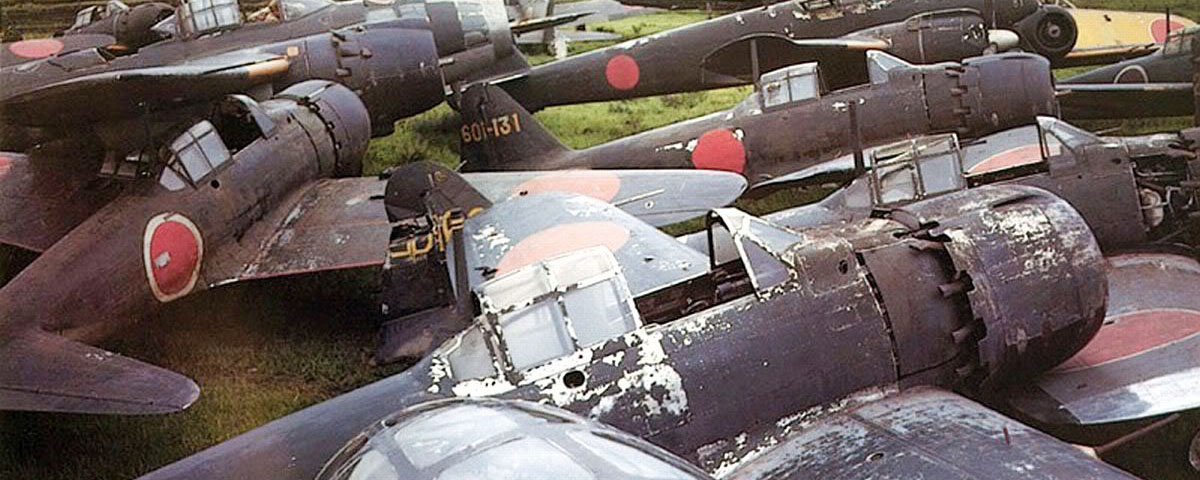aidenmac16
Airman
- 32
- Oct 15, 2024
Which materials did Imperial Japanese Armies use to make airfields during the Pacific Theater campaigns in general?
Cheers, aidenmac16
Cheers, aidenmac16
Follow along with the video below to see how to install our site as a web app on your home screen.
Note: This feature may not be available in some browsers.
Ad: This forum contains affiliate links to products on Amazon and eBay. More information in Terms and rules

Interesting article.Not exactly your answer, but provided some insight:

Japan's Fatally Flawed Air Forces in World War II
World War II in the Pacific was a fight to seize and defend airfields. The Japanese made gaining and maintaining control of the air as much a requirementwww.historynet.com
It's noteworthy how many of Japan's former ww2 airfields are still in use today, often as commercial airports. Most of these were cut out of the jungle or rough terrain by Japan's engineers and often forced labour. Here's two dozen I found on Google when I searched for ww2 airfields made by Japan still in use today.
- Ballalae Airport (Shortland Islands)
- Bauerfield International Airport (Vanuatu)
- Bonriki International Airport (Kiribati)
- Chuuk International Airport (Federated States of Micronesia)
- Daru Airport (Western Province, Papua New Guinea)
- Domine Eduard Osok Airport (Sorong, Indonesia)
- Frans Kaisiepo International Airport (Biak, Indonesia)
- Gurney Airport (Milne Bay, Papua New Guinea)
- Honiara International Airport (formerly Henderson Field, Guadalcanal)
- Jacksons International Airport (Port Moresby, Papua New Guinea)
- Madang Airport (Madang, Papua New Guinea)
- Munda Airport (New Georgia Island)
- Nadzab Airport (Lae, Papua New Guinea)
- Nauru International Airport (Nauru)
- Pagan Airfield (Northern Mariana Islands, USA)
- Palau International Airport (Palau)
- Peleliu Airfield (Palau)
- Rota International Airport (Northern Mariana Islands, USA)
- Sam Ratulangi International Airport (Manado, Indonesia)
- Sentani International Airport (Jayapura, Indonesia)
- Sultan Babullah Airport (Ternate, Indonesia)
- Tinian International Airport (Northern Mariana Islands, USA)
- Wewak International Airport (Wewak, Papua New Guinea)
- Yap International Airport (Federated States of Micronesia)
View attachment 814194
It's a great list. Honiara airport is on my bucket list.It's noteworthy how many of Japan's former ww2 airfields are still in use today, often as commercial airports. Most of these were cut out of the jungle or rough terrain by Japan's engineers and often forced labour. Here's two dozen I found on Google when I searched for ww2 airfields made by Japan still in use today.
- Ballalae Airport (Shortland Islands)
- Bauerfield International Airport (Vanuatu)
- Bonriki International Airport (Kiribati)
- Chuuk International Airport (Federated States of Micronesia)
- Daru Airport (Western Province, Papua New Guinea)
- Domine Eduard Osok Airport (Sorong, Indonesia)
- Frans Kaisiepo International Airport (Biak, Indonesia)
- Gurney Airport (Milne Bay, Papua New Guinea)
- Honiara International Airport (formerly Henderson Field, Guadalcanal)
- Jacksons International Airport (Port Moresby, Papua New Guinea)
- Madang Airport (Madang, Papua New Guinea)
- Munda Airport (New Georgia Island)
- Nadzab Airport (Lae, Papua New Guinea)
- Nauru International Airport (Nauru)
- Pagan Airfield (Northern Mariana Islands, USA)
- Palau International Airport (Palau)
- Peleliu Airfield (Palau)
- Rota International Airport (Northern Mariana Islands, USA)
- Sam Ratulangi International Airport (Manado, Indonesia)
- Sentani International Airport (Jayapura, Indonesia)
- Sultan Babullah Airport (Ternate, Indonesia)
- Tinian International Airport (Northern Mariana Islands, USA)
- Wewak International Airport (Wewak, Papua New Guinea)
- Yap International Airport (Federated States of Micronesia)
View attachment 814194
It's noteworthy how many of Japan's former ww2 airfields are still in use today, often as commercial airports. Most of these were cut out of the jungle or rough terrain by Japan's engineers and often forced labour. Here's two dozen I found on Google when I searched for ww2 airfields made by Japan still in use today.
- Ballalae Airport (Shortland Islands)
- Bauerfield International Airport (Vanuatu)
- Bonriki International Airport (Kiribati)
- Chuuk International Airport (Federated States of Micronesia)
- Daru Airport (Western Province, Papua New Guinea)
- Domine Eduard Osok Airport (Sorong, Indonesia)
- Frans Kaisiepo International Airport (Biak, Indonesia)
- Gurney Airport (Milne Bay, Papua New Guinea)
- Honiara International Airport (formerly Henderson Field, Guadalcanal)
- Jacksons International Airport (Port Moresby, Papua New Guinea)
- Madang Airport (Madang, Papua New Guinea)
- Munda Airport (New Georgia Island)
- Nadzab Airport (Lae, Papua New Guinea)
- Nauru International Airport (Nauru)
- Pagan Airfield (Northern Mariana Islands, USA)
- Palau International Airport (Palau)
- Peleliu Airfield (Palau)
- Rota International Airport (Northern Mariana Islands, USA)
- Sam Ratulangi International Airport (Manado, Indonesia)
- Sentani International Airport (Jayapura, Indonesia)
- Sultan Babullah Airport (Ternate, Indonesia)
- Tinian International Airport (Northern Mariana Islands, USA)
- Wewak International Airport (Wewak, Papua New Guinea)
- Yap International Airport (Federated States of Micronesia)
View attachment 814194
Well, Google lets me down again.That list appears to have some errors,
Well, Google let's me down again.
The IJN started work on "Henderson" which was the big driver for the U.S. assault on Guadal Canal. At least according to the sub par histories I used to read.Think yanks did something to those too.
Interesting. A web search confirmed it was partially built by the Japanese before the US Marines captured it. One of my family was there when the Japanese were trying to take it off the Americans and Kiwis and he remembered it as a prewar strip that was never in Japanese hands. Must have been wartime propaganda. Some USAAF and RNZAF units pulled back to Espirito Santo at one stage during one Japanese attack and he was most annoyed about that because the RNZAF lost two Hudsons in the move - all were greatly overloaded and most running on fumes on arrival there. Later they found that the Japanese had never got close enough to actually prevented operations from the strip.
